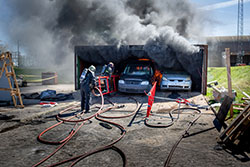Published 22.05.25
The fire safety of Danish battery systems (BESS systems) can be improved by incorporating international experience. A new DBI report compares Danish and international guidelines in this field and provides concrete recommendations.
Most people know that a fire in an electric car battery can be extremely difficult to extinguish. Since fires in large batteries release energy over a prolonged period, such as during a ‘thermal runaway’, firefighters often resort to submerging the entire car in a water-filled container.
But when these large batteries are used as energy storage in commercial settings, the challenges grow even larger. Battery Energy Storage Systems (BESS) often contain 20 to 30 times more energy than a car battery, are installed in proximity to buildings with people, and require prolonged firefighting efforts in case of a fire.
Authorities and emergency services around the world are trying to determine the best way to handle the risks that BESS installations entail. In Denmark, the Danish Emergency Management Agency (DEMA) published a ‘Guideline on Fire Safety for Larger Lithium-Ion Battery Storages and BESS‘ in 2023.
In a new report, DBI has compared the Danish guidelines with those from other countries to identify possible gaps and offers recommendations on how the Danish guidelines can be improved by drawing from international experience.
- We can see that other countries are further ahead in several areas. In Denmark, the focus has so far primarily been on how the fire service should handle a fire, and less on how to prevent it, says Rasmus Æbelø, Fire Safety Consultant at DBI and co-author of the report.
The report provides a list of areas where Danish authorities and stakeholders can seek inspiration and strengthen fire safety measures for the growing number of battery installations.
In Sweden and Belgium, operators must conduct a risk assessment in the form of an analysis of possible incidents – including fire, gas leaks, or explosions – and assess how the location and design of the installation affect safety. In Denmark, there is no regulatory requirement for such a risk assessment.
- Today, it hasn’t even been determined whether a risk assessment is necessary when building a battery system. This means that some systems are planned and built without having considered what could happen in the event of a fault or fire, says Rasmus Æbelø, and adds:
- The difference stems from the fact that other countries have a tradition of using risk assessments actively for fire safety, while Denmark typically relies on pre-approved solutions for building fire protection.
Another area where Denmark lags behind is in the testing of battery systems themselves. Several countries – including the U.S. – increasingly use the UL 9540A test, which simulates a worst-case fire scenario to investigate heat development, fire spread, gas emissions, etc.
- A standardized test provides valuable insights that can be used to plan, for example, ventilation and extinguishing strategies. But in Denmark, there is no requirement to perform such a test. This is particularly problematic for battery systems that emit flammable gases, says Rasmus Æbelø.
Without standardized testing, it is harder to assess the fire risk in Danish systems, and fire safety measures are therefore more based on assumptions and estimates than on documented data.
If a large battery system catches fire, emergency responders will typically use tens of thousands of liters of water to extinguish it. International studies have shown that the extinguishing water can become contaminated – posing environmental and health risks.
In Sweden and Australia, the guidelines offer concrete recommendations on how this contaminated water should be collected and handled. This includes impervious surfaces, drainage systems, and temporary storage basins. In Denmark, contaminated extinguishing water is not mentioned in the current guidelines.
- This is a risk we really need to investigate. One solution that could be considered is whether some battery fires might be allowed to burn out safely on site, says Rasmus Æbelø.
In the event of a fire in an enclosed battery system, dangerous levels of flammable gases can build up and risk causing an explosion. This has been documented by DBI in the BESAFE project. Therefore, several international guidelines require ventilation and pressure relief systems.
In Sweden, for example, a distinction is made between explosion ventilation (automatic extraction upon gas detection) and smoke ventilation (smoke removal to assist emergency responders). In Denmark, it is merely recommended to consider ventilation for larger systems – but it is not required.
- There is a lot of knowledge and experience in the industry, but we need to compile and formalize it so that advisors and developers have a foundation to rely on. The new report gives us a shared starting point – both for developing new guidelines and for creating a common understanding of what constitutes good practice, says Rasmus Æbelø.
He hopes the report can be used for both project planning and as a basis for future regulations:
- When a client wants to install a large indoor battery system, I can now say: Here are some considerations from abroad that would be wise to include – even if they are not currently required in Denmark.
The report does not claim that Denmark is poorly positioned, but rather that there is a lack of uniformity and coherence in the approach. For some stakeholders, this results in an extremely high – and possibly unnecessarily high – safety level. For others, it may be unclear what is actually expected.
- In a project I was involved in, we chose – in consultation with the emergency services – to go above and beyond. There is a sprinkler system, fire ventilation, extra-thick walls, and a remote location, simply because it is hard to assess what is necessary when we don’t have clear guidelines, says Rasmus Æbelø, and continues:
- In the long term, we hope for more robust guidelines with clear expectations – especially regarding installation conditions, risk assessments, and documentation. That also makes it easier to approve new projects, because we know where they can be placed in a safe and responsible manner, he says.
Read the report: Battery Energy Storage Systems (BESS) – Overview of guidelines from Denmark, Belgium, Sweden, UK, USA and other selected countries.
The DBI report offers several recommendations for improving Danish fire safety guidelines for battery systems (BESS), including:
| Area | Recommendation |
| Documentation and Responsibility | Clarify who is responsible for documentation throughout the system’s lifetime. Introduce requirements for necessary documents. |
| Risk Assessment | Require risk analysis and hazard mitigation, especially for non-standard systems. Provide guidance on execution. |
| Thermal Runaway | Specify how to prevent and handle thermal runaway – not just via gas detectors. |
| Mechanical Impact | Identify and mitigate risks such as collisions, dropped objects, or mishandling. |
| Fire and Explosion Testing | Refer to international testing standards like UL 9540A. Introduce testing requirements for Danish systems. |
| Separation and Distance | Evaluate if current distance requirements are sufficient – especially in case of explosion. |
| Ventilation and Detection | Clarify when gas/smoke alarms and ventilation are required. Refer to relevant gases. |
| Fire Suppression | Specify when sprinklers or other suppression methods must be used. Define water volumes and collection requirements. |
| Operation and Training | Set minimum standards for monitoring, operational procedures, and staff training intervals. |
| Shutdown | Develop guidelines for safe shutdown of active BESS systems. |

Ana Sauca
Project Manager
+45 50 80 65 51

Agata Gallas-Hulin
Battery Program Manager
